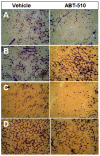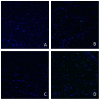Chronic delivery of a thrombospondin-1 mimetic decreases skeletal muscle capillarity in mice
- PMID: 23405239
- PMCID: PMC3566122
- DOI: 10.1371/journal.pone.0055953
Chronic delivery of a thrombospondin-1 mimetic decreases skeletal muscle capillarity in mice
Abstract
Angiogenesis is an essential process for normal skeletal muscle function. There is a growing body of evidence suggesting that thrombospondin-1 (TSP-1), a potent antiangiogenic protein in tumorigenesis, is an important regulator of both physiological and pathological skeletal muscle angiogenesis. We tested the hypothesis that chronic exposure to a TSP-1 mimetic (ABT-510), which targets the CD36 TSP-1 receptor, would decrease skeletal muscle capillarity as well as alter the balance between positive and negative angiogenic proteins under basal conditions. Osmotic minipumps with either ABT-510 or vehicle (5% dextrose) were implanted subcutaneously in the subscapular region of C57/BL6 mice for 14 days. When compared to the vehicle treated mice, the ABT-510 group had a 20% decrease in capillarity in the superficial region of the gastrocnemius (GA), 11% decrease in the plantaris (PLT), and a 35% decrease in the soleus (SOL). ABT-510 also decreased muscle protein expression of vascular endothelial growth factor (VEGF) in both the GA (-140%) and SOL (-62%); however there was no change in VEGF in the PLT. Serum VEGF was not altered in ABT-510 treated animals. Endogenous TSP-1 protein expression in all muscles remained unaltered. Tunnel staining revealed no difference in muscle apoptosis between ABT-510 and vehicle treated groups. These data provide evidence that the anti-angiogenic effects of TSP-1 are mediated, at least in part, via the CD36 receptor. It also suggests that under physiologic conditions the TSP-1/CD36 axis plays a role in regulating basal skeletal muscle microvessel density.
Conflict of interest statement
Figures





References
-
- Breen EC, Johnson EC, Wagner H, Tseng HM, Sung LA, et al. (1996) Angiogenic growth factor mRNA responses in muscle to a single bout of exercise. Journal of Applied Physiology 81: 355–361. - PubMed
-
- Olfert IM, Birot O (2011) Importance of Anti-angiogenic Factors in the Regulation of Skeletal Muscle Angiogenesis. Microcirculation 18: 316–330. - PubMed
-
- Jack L (2000) The functions of thrombospondin-1 and-2. Current Opinion in Cell Biology 12: 634–640. - PubMed
Publication types
MeSH terms
Substances
Grants and funding
LinkOut - more resources
Full Text Sources
Other Literature Sources
Miscellaneous

